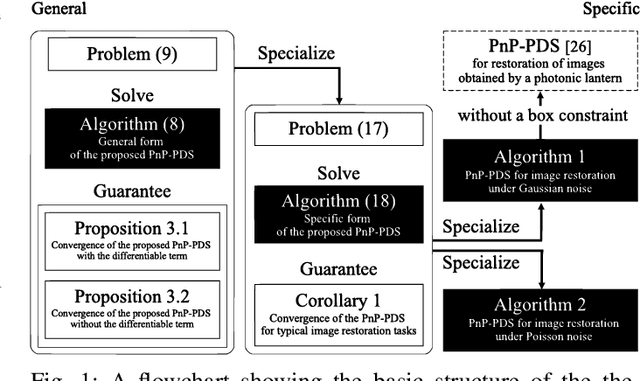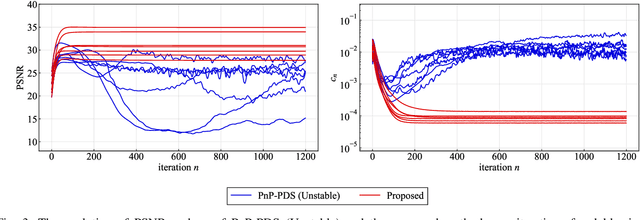Ryosuke Isono
Convergent Primal-Dual Plug-and-Play Image Restoration: A General Algorithm and Applications
Jan 07, 2025



Abstract:We propose a general deep plug-and-play (PnP) algorithm with a theoretical convergence guarantee. PnP strategies have demonstrated outstanding performance in various image restoration tasks by exploiting the powerful priors underlying Gaussian denoisers. However, existing PnP methods often lack theoretical convergence guarantees under realistic assumptions due to their ad-hoc nature, resulting in inconsistent behavior. Moreover, even when convergence guarantees are provided, they are typically designed for specific settings or require a considerable computational cost in handling non-quadratic data-fidelity terms and additional constraints, which are key components in many image restoration scenarios. To tackle these challenges, we integrate the PnP paradigm with primal-dual splitting (PDS), an efficient proximal splitting methodology for solving a wide range of convex optimization problems, and develop a general convergent PnP framework. Specifically, we establish theoretical conditions for the convergence of the proposed PnP algorithm under a reasonable assumption. Furthermore, we show that the problem solved by the proposed PnP algorithm is not a standard convex optimization problem but a more general monotone inclusion problem, where we provide a mathematical representation of the solution set. Our approach efficiently handles a broad class of image restoration problems with guaranteed theoretical convergence. Numerical experiments on specific image restoration tasks validate the practicality and effectiveness of our theoretical results.
Robust Spatiotemporal Fusion of Satellite Images: A Constrained Convex Optimization Approach
Aug 01, 2023



Abstract:This paper proposes a novel spatiotemporal (ST) fusion framework for satellite images, named Robust Optimization-based Spatiotemporal Fusion (ROSTF). ST fusion is a promising approach to resolve a trade-off between the temporal and spatial resolution of satellite images. Although many ST fusion methods have been proposed, most of them are not designed to explicitly account for noise in observed images, despite the inevitable influence of noise caused by the measurement equipment and environment. Our ROSTF addresses this challenge by treating the noise removal of the observed images and the estimation of the target high-resolution image as a single optimization problem. Specifically, first, we define observation models for satellite images possibly contaminated with random noise, outliers, and/or missing values, and then introduce certain assumptions that would naturally hold between the observed images and the target high-resolution image. Then, based on these models and assumptions, we formulate the fusion problem as a constrained optimization problem and develop an efficient algorithm based on a preconditioned primal-dual splitting method for solving the problem. The performance of ROSTF was verified using simulated and real data. The results show that ROSTF performs comparably to several state-of-the-art ST fusion methods in noiseless cases and outperforms them in noisy cases.
 Add to Chrome
Add to Chrome Add to Firefox
Add to Firefox Add to Edge
Add to Edge